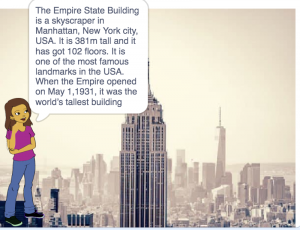Activity: Virtual Tour of U.S. cities using Scratch
23/10/21
By Giovanna Caracciolo, English language teacher at IC Laureana Galatro Feroleto. Italy
When passion and creativity meet technology something special happens and unusual pathways can be disclosed. All of a sudden students shake off feelings of boredom and apathy and become the main characters of their learning process. This is what I’ve been experiencing since I started using coding as a classroom activity. I’m an English Language Teacher at a Lower-Secondary school in Italy and I’m always looking for new strategies and tools to help students achieve their educational goals. When I came across coding two years ago I felt it would be an involving and funny way to stimulate students and so it was. Since then I’ve carried out a few projects using Scratch and coding and I’ve tried to widen my students’ horizons by taking part in European projects. #CodeWeek initiative gave us the opportunity to put ourselves out there and to get involved in a European challenge. We took part in the “Code Week 4 All” challenge by sharing the code of a Romanian colleague who we successfully worked with on an eTwinning project about coding and music last year.
The activity I organized this year is focused on a non-traditional lesson plan about U.S. cities. In fact, I asked a group of my students (Class 3C) to create interactive maps with monuments and attractions using Scratch.

They worked in little groups and each of them was given a different city: after choosing the monuments they would put on the map, they looked for some historical information and wrote a brief description in English. Then they used Scratch to animate sprites and change backdrops in order to create an interactive tourist guide.
Here you can find some scenes of NY’s interactive map. Other maps are being built and we’re going to record the descriptions, making the sprites talk!



We’re really enjoying our activity and we’re creating a friendly and warm learning environment where students are encouraged to use creativity and innovation. Therefore I’m sure that coding, if introduced in the classroom, would represent an added value to the teaching and learning process.


